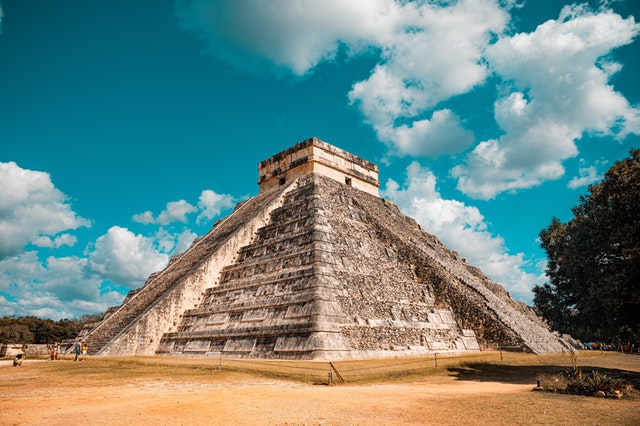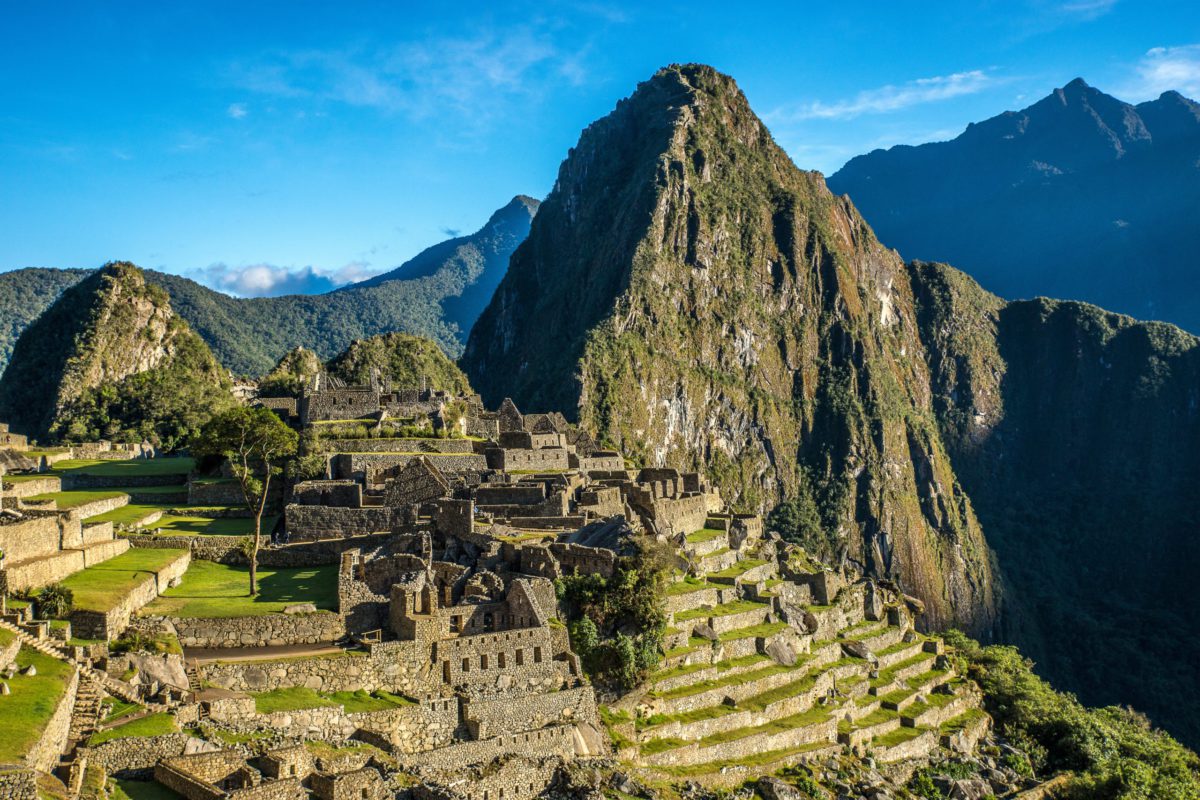Table of Contents
- El Castillo, Tulum
- Great Pyramid of La Venta, La Venta
- La Iglesia, Cobá
- Pyramid of the Niches, El Tajín
- Pyramid of the Inscriptions, Palenque
- The Pyramid of the Magician, Uxmal
- The Great Pyramid, Calakmul
- The Pyramids of the Sun and the Moon, Teotihuacán
- Nohoch Mul Pyramid, Cobá
- Castillo de Kukulcán, Chichén Itzá
There are a million reasons to visit Mexico, especially now that travel is opening back up post-COVID. This incredible country has beautiful beaches, delicious food, and vibrant nightlife, but there is so much more to see. Did you know Mexico is home to many ancient archeological sites that showcase the history of Mesoamerica and the Mayan culture? Check out the top 10 pyramids in Mexico and add them to your must-see bucket list!
El Castillo, Tulum
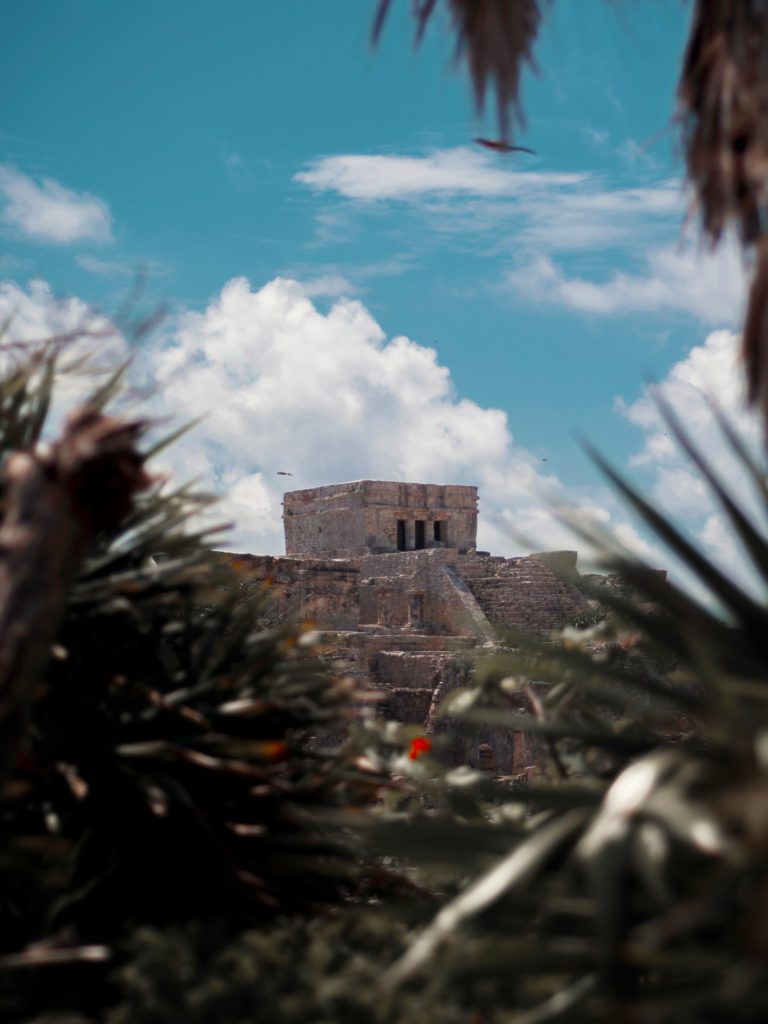
The first pyramid on the list may not be one of the biggest pyramids in Mexico, but El Castillo in Tulum is a must-see. This lookout tower sits right on the shoreline with views of the turquoise sea and white-sand beach. Based on its prime location, it was thought to be a trading post with other sites, such as Chichén Itzá and Cobá. This location also led the way for leadership and spiritual practices, as many historians feel Tulum was one of the most powerful cities in Mexico in the 13th and 14th centuries. However, it’s believed Tulum was constructed as early as 564 A.D.
Tulum was an important Mesoamerican site and features both Mayan and Toltec history. This ancient fortress houses the only Mayan ruins in Mexico that sit on a shoreline. It’s also the only Mayan site that features a protective border wall encompassing the city. Many feel Tulum was the last site of the Mayan civilization, which was abandoned sometime after the arrival of the Spanish in the 16th century. While there is still much debate about the timeline and purpose of Tulum, this fortress is a must-see as more is learned about its inhabitants and use every day.
Great Pyramid of La Venta, La Venta
The Great Pyramid of La Venta is a lesser-known pyramid in the tourism world. While many aren’t aware of its existence, it’s the oldest and one of the most important pyramids in Mexico. La Venta is an ancient Olmec settlement on a swampy island inhabited between 800 and 400 B.C., but some now believe humans were farming there as far back as 1750 B.C. The pyramid is made out of clay, extends 33 meters high, and reflects the sacred properties of a mountain. Many also feel this structure was a religious site used for rituals that aligned with the stars above.
La Venta was home to thousands of people. It was the only city of its kind at the time it was inhabited. The site itself featured tombs and basalt monuments, the most iconic being four large, carved stone heads. The heads, along with most of the artifacts found near the pyramid, now reside at the Parque-Museo La Venta. You can take a boat tour through the river system to see this incredible piece of antiquity and explore the excavated pieces at the outdoor archeological park in Villahermosa.
La Iglesia, Cobá
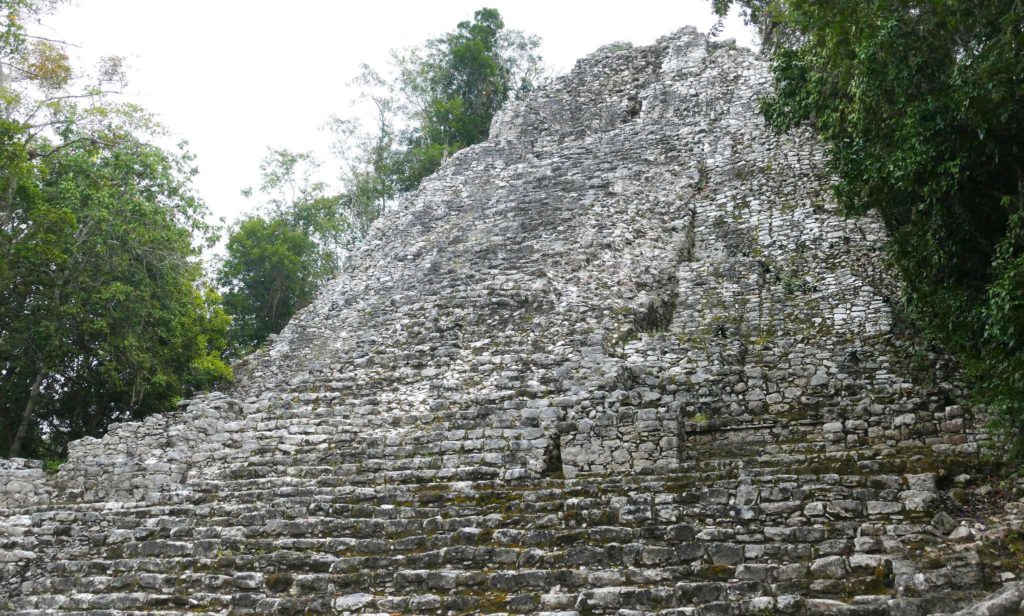
While many may know the Cobá Archeological Zone for its other grand pyramid, La Iglesia (“The Church”), is nothing to sleep on, as it’s the second-largest structure in the park. This nine-level pyramid dates back to 550 A.D. and is believed to be a place where spiritual ceremonies were held. You’ll find many carved symbols and figurines throughout this structure.
Historians estimate Cobá was home to nearly 50,000 people. It’s located between two lakes with several more in the surrounding area. It features 6,500 known structures, making it the largest known site of Mayan ruins in Mexico. The site itself dates back to 50 B.C., and many believe it was abandoned by 1100 A.D. as Tulum and Chichén Itzá grew in importance and power.
Pyramid of the Niches, El Tajín
The Pyramid of the Niches stands 20 meters tall, has four sides, and features seven terraces. Due to weather and time, one of the terraces has since been destroyed. The structure, aptly named for its 365 niches, represents the 365-day cycle of the year. It’s rich with other numerological symbolism that is found in many other pyramids in Mexico. One specific area houses 18 niches that could correspond to the 18 months of the Mesoamerican calendar. Most believe the Pyramid of Niches was built between 1100 and 1150 A.D. Even after the civilization’s fall, locals in the area maintained this particular temple, as it has great significance in regards to the solar year and ancient religious underpinnings.
El Tajin flourished from 800 through 1200 A.D., between the fall of Teotihuacán and the rise of the Aztecs. Not much is known about its inhabitants, but many scholars believe the ancestors of the Totonac and Huastec indigenous people ruled this ancient city as their descendants still reside in the area to this day. It’s estimated that up to 20,000 people lived there at its peak and was a significant trade center in Mesoamerica.
Pyramid of the Inscriptions, Palenque
The Pyramid of Inscriptions gets its name from the hieroglyphs that cover the inside of its structure and is one of the best representations of a Maya funerary pyramid throughout Mexico. The glyphs tell the story of the city and its most iconic ruler, Pakal, who is buried in the lowest chamber of the pyramid underneath the structure itself. The pyramid contains nine levels that mirror the nine stages in the underworld and features a well-known carved image of Pakal floating in between the heavens and the underworld. No other tomb in the Americas features such intricate designs. The Pyramid of Inscriptions resembles the ornate detailing that you’d find in Egypt rather than the pyramids in Mexico.
Palenque, formally known as Lakamha meaning “Big Water”, is believed to have been built around 432 A.D. However, it didn’t reach its peak until 600 through 900 A.D. when Pakal and his sons ruled the area. They expanded greatly on the Palenque grounds over a 200-year period to ensure this sacred place would be remembered by all who saw it.
The Pyramid of the Magician, Uxmal
The Pyramid of the Magician’s name comes from an ancient tale called Leyenda del Enano de Uxmal or The Legend of the Uxmal’s Dwarf. The legend states the dwarf, who some believe was a magician-god named Itzamna, built the temple in one night with the help of his mother who was a witch. It’s estimated that the pyramid was first constructed in 600 A.D., and the last additions were completed around 1000 A.D. The structure is over 30 meters tall and is believed to have been used on sacred days for rituals. The structure features ornate stonework and carvings throughout.
It’s believed the city of Uxmal was inhabited through the 10th century and was abandoned completely when the Spanish came to the area. Some feel the complex was used for religious ceremonies, while others believe there was a sacred or secret school within the grounds. Many of the buildings in Uxmal aligned with the solstice and the planet Venus, which reinforces the former.
The Great Pyramid, Calakmul
The Great Pyramid of Calakmul is located in the Calakmul Biosphere Reserve. It stands 53 meters high, making it the tallest pyramid in the Yucatan and Mayan world. The base of the pyramid alone covers five acres of land. While not much is known about the purpose of the pyramid, archeologists do know additions were added to the structure. It houses a series of shrines, including nine royal tombs filled with riches that were found buried inside.
The ancient city of Calakmul sits 22 miles away from the Guatemalan border. Its location tells a story of the rivaling city of Tikal, known for its large step pyramid. They fought for power until 900 A.D. when both cities collapsed and were abandoned. Archeologists believe the construction of Calakmul began around 6 B.C., contains over 7,000 structures, and housed around 65,000 people during its prime.
The Pyramids of the Sun and the Moon, Teotihuacán
On the Avenue of the Dead in the city of Teotihuacán, you’ll find the Pyramid of the Sun and Pyramid the Moon. The Pyramid of the Sun is the larger of the two. It stands 63 meters tall and contains several underground tunnel systems that were believed to have birthed the first humans based on local lore. Within the deep pit of the pyramid, archeologists found the remnants of fire and water rituals, along with a statue of Huehueteotl, a well-known Mesoamerican god who was worshipped throughout the area. Historians believe the Pyramid of the Sun was completed around 200 A.D.
The Pyramid of the Moon sits across from the Pyramid of the Sun on the other end of the avenue. It’s estimated to have been completed around 250 A.D. One major tomb was discovered at this site, and now archeologists believe there could be many more deep within the pyramid. This temple was used as a place for rituals, as it was built to worship the Great Goddess who was the ruler of creation, water, and fertility.
Not much is known about the original inhabitants of the ancient city of Teotihuacán. In the 1400s, the Aztecs discovered this abandoned city and gave it its name meaning “the place where the gods were created”. However, historians believe these structures predate the Toltecs. At the site, they’ve also found remnants of the Maya, Mixtec, and Zapotec cultures within its remains. Masks, tools, animal bones, blades, and figurines are just some of the items that have been uncovered at this ancient place.
Nohoch Mul Pyramid, Cobá
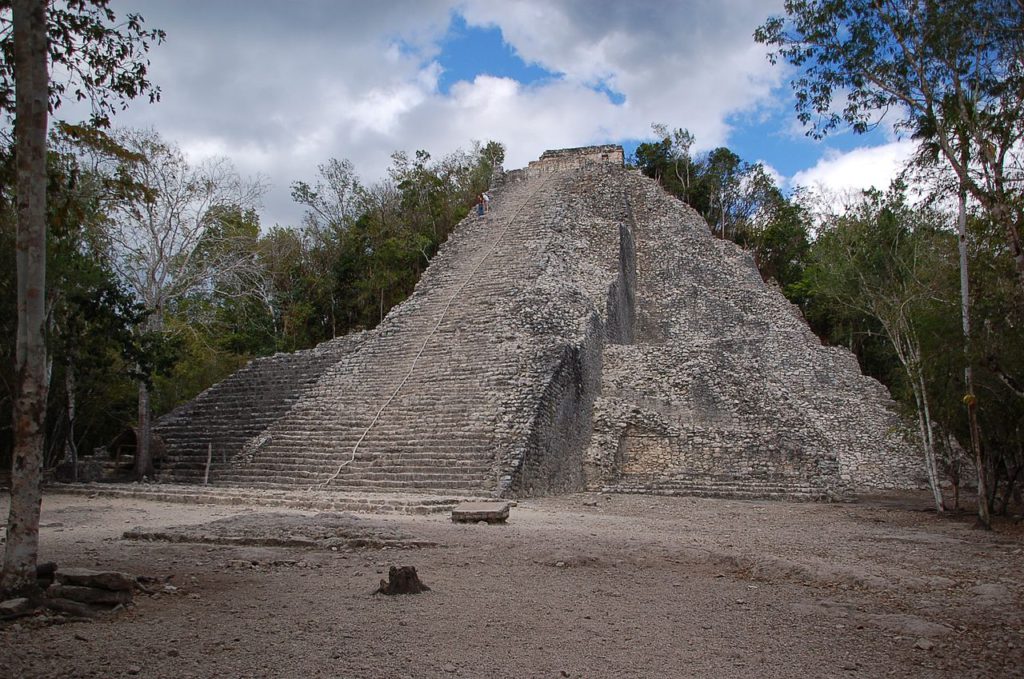
We met Cobá’s second-largest pyramid earlier in this list, and now we meet its first. This is Nohoch Mul, which translates to “large mound” in the Mayan language. This grand pyramid is the second tallest in all of Mexico. From the top, you can observe the surrounding lakes and the massive size of the city itself. Many believe this structure was used for religious ceremonies, as two gods are carved into the doorway of the temple at the top.
Travel around this sacred site using the sacbeobs, or raised stone roadways, that connect throughout the park. These ancient pathways give us a glimpse into what it was like to live here during antiquity.
Castillo de Kukulcán, Chichén Itzá
No trip to Mexico is complete without a trip to Castillo de Kukulcán at Chichén Itzá. This ancient masterpiece is one of the most iconic and recognizable pyramids in all of Mexico with its four staircases and picturesque jungle backdrop. Castillo de Kukulcán is 24 meters high and has 365 steps, just like the Pyramid of the Niches in El Tajín. What makes Castillo de Kukulcán special is its alignment with the spring and autumn equinoxes. During these times, the sun casts shadows on the sides of the stairways, which gives the appearance of a snake slithering down the stairs. The shadows connect to the sculpted snake heads at the bottom of each stairway. At the top of the pyramid, you’ll also find a carving of Quetzalcóatl, a popular feathered serpent god among the Mesoamerican people, who symbolizes creation, art, and knowledge.
Chichén Itzá came to power around 600 A.D. It maintained prosperity until 1200 A.D., but many think the area was settled around 450 A.D. In 2007, Chichén Itzá was named one of the new seven wonders of the world. With so many tourists making the journey to visit this ancient place, researchers are able to learn more about the mysteries of the Mayans and the pyramids of Mexico with each passing day.
About TourHero
TourHero is a social travel platform that enables you to travel with like-minded people and fall in love with the journey. We work closely with handpicked local operators to ensure every experience curated is unique and exclusive to your travel group. Come with us on epic adventures and create memories that last a lifetime!
